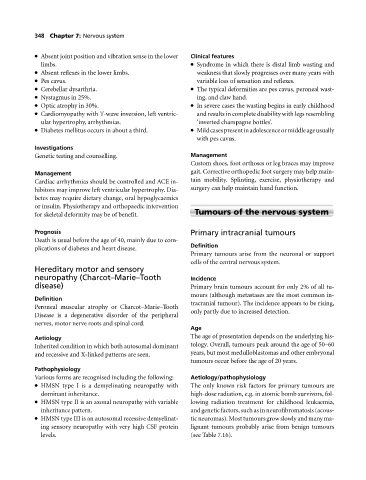Page 352 - Medicine and Surgery
P. 352
P1: FAW
BLUK007-07 BLUK007-Kendall May 25, 2005 18:18 Char Count= 0
348 Chapter 7: Nervous system
Absent joint position and vibration sense in the lower Clinical features
limbs. Syndrome in which there is distal limb wasting and
Absent reflexes in the lower limbs. weakness that slowly progresses over many years with
Pes cavus. variable loss of sensation and reflexes.
Cerebellar dysarthria. The typical deformities are pes cavus, peroneal wast-
Nystagmus in 25%. ing, and claw hand.
Optic atrophy in 30%. In severe cases the wasting begins in early childhood
Cardiomyopathy with T-wave inversion, left ventric- and results in complete disability with legs resembling
ular hypertrophy, arrhythmias. ‘inverted champagne bottles’.
Diabetes mellitus occurs in about a third. Mildcasespresentinadolescenceormiddleageusually
with pes cavus.
Investigations
Genetic testing and counselling. Management
Custom shoes, foot orthoses or leg braces may improve
Management gait. Corrective orthopedic foot surgery may help main-
Cardiac arrhythmias should be controlled and ACE in- tain mobility. Splinting, exercise, physiotherapy and
hibitors may improve left ventricular hypertrophy. Dia- surgery can help maintain hand function.
betes may require dietary change, oral hypoglycaemics
or insulin. Physiotherapy and orthopaedic intervention
Tumours of the nervous system
for skeletal deformity may be of benefit.
Prognosis Primary intracranial tumours
Death is usual before the age of 40, mainly due to com-
Definition
plications of diabetes and heart disease.
Primary tumours arise from the neuronal or support
cells of the central nervous system.
Hereditary motor and sensory
neuropathy (Charcot–Marie–Tooth Incidence
disease) Primary brain tumours account for only 2% of all tu-
mours (although metastases are the most common in-
Definition
tracranial tumour). The incidence appears to be rising,
Peroneal muscular atrophy or Charcot–Marie–Tooth
only partly due to increased detection.
Disease is a degenerative disorder of the peripheral
nerves, motor nerve roots and spinal cord.
Age
Aetiology The age of presentation depends on the underlying his-
Inherited condition in which both autosomal dominant tology. Overall, tumours peak around the age of 50–60
and recessive and X-linked patterns are seen. years, but most medulloblastomas and other embryonal
tumours occur before the age of 20 years.
Pathophysiology
Various forms are recognised including the following: Aetiology/pathophysiology
HMSN type I is a demyelinating neuropathy with The only known risk factors for primary tumours are
dominant inheritance. high-dose radiation, e.g. in atomic bomb survivors, fol-
HMSN type II is an axonal neuropathy with variable lowing radiation treatment for childhood leukaemia,
inheritance pattern. and genetic factors, such as in neurofibromatosis (acous-
HMSN type III is an autosomal recessive demyelinat- ticneuromas).Mosttumoursgrowslowlyandmanyma-
ing sensory neuropathy with very high CSF protein lignant tumours probably arise from benign tumours
levels. (see Table 7.16).

